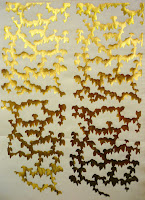 In the print workshop we were shown a variety of different methods and effects that could be achieved using a silk screen. The effects we could achieve by applying different chemicals and paints to the surface of a material were really interesting and varied. Before we started trying out techniques such as devoré and flocking, we were given an introduction into paint silk screening using pre-prepared screens to get used to the method and to test out colours and layering. Most of the pigments we used were water based as this prevents the screen from becoming blocked, the pigment doesn't actually dye the material but sit on the surface and need to be heat fixed to stop them from washing off.
In the print workshop we were shown a variety of different methods and effects that could be achieved using a silk screen. The effects we could achieve by applying different chemicals and paints to the surface of a material were really interesting and varied. Before we started trying out techniques such as devoré and flocking, we were given an introduction into paint silk screening using pre-prepared screens to get used to the method and to test out colours and layering. Most of the pigments we used were water based as this prevents the screen from becoming blocked, the pigment doesn't actually dye the material but sit on the surface and need to be heat fixed to stop them from washing off.We were also shown heat transfer when dye is painted onto paper and when heated becomes fixed to a fabric surface, however the colours were difficult to judge as they became a lot more vivid after heat was applied and the effects were quite rough and unsophisticated.
Devoré is a technique which destroys part of a mixed fibre fabric to leave a slightly see-through material. The paste formula is screen printed onto the fabric, left to dry and then heated till it is slightly burnt and brown coloured, this is then washed off to leave the finished piece. The paste burns away all the natural fibres in the fabric so if the material was 100% natural then it would either fall apart, depending on how close and detailed the pattern, or would leave holes in the material. I liked this method though I doubt I could apply it to anything in this project, but it could prove useful in another.
I particularly liked the effect of the flock printing which gives a velour texture. A water based adhesive resin is painted onto the surface, once dry the area is covered with paper backed viscose velvet and fixed through heat. I liked the raised textured finish the flock gave to the cardboard sample in the top image. I also tried applying it to acetate and although it went slightly translucent it did stick to the surface though if it was rubbed it would come off.
We were also shown foil printing. The whole process is very similar to flocking but instead of using a sheet of flock, a piece of foil is adhered using heat. I liked the effect I got from the foiling when using my own screen, I think the leaves look really successful in gold and I also like the negative that I was left with.
The final technique we were shown was puff binder, this is screen printed onto a surface and when heat is applied to it the puff binder expands for a 3D effect. I found that with all the techniques I preferred them when applied to a non fabric surface, although they're designed to be used with fabric so that they adhere to the surface, I found the finished effect far more interesting. I really want to test out some more designs and make some more of my own screens, it might not be applicable to this project but the I found the whole workshop really useful.


No comments:
Post a Comment